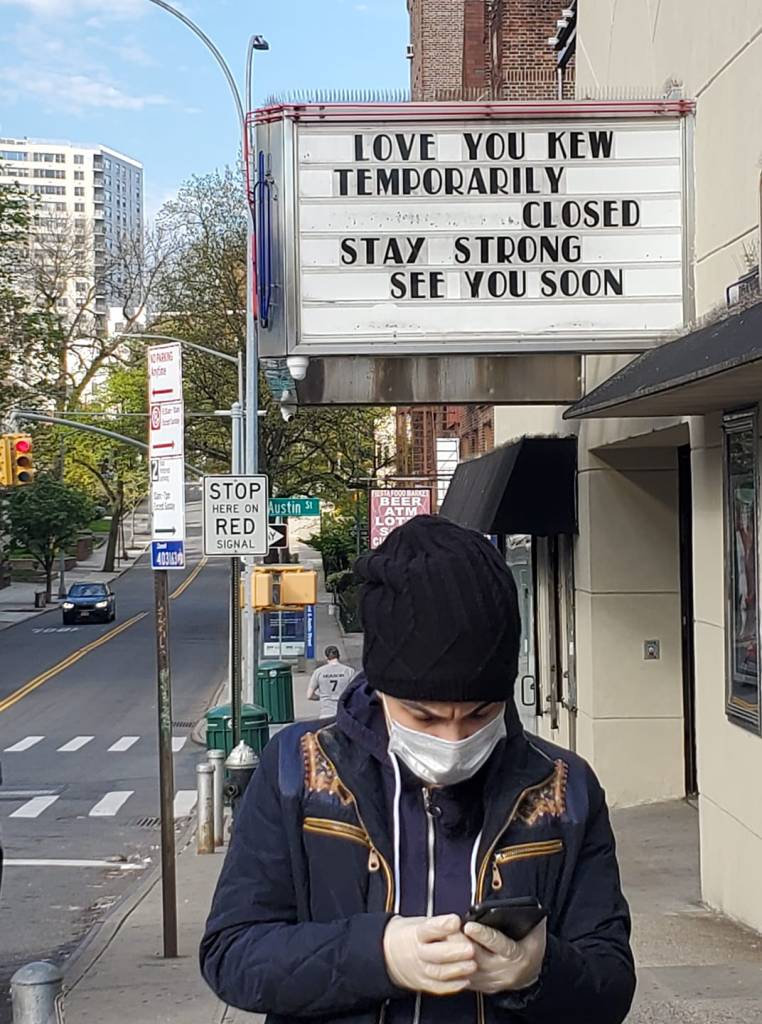My son runs into the room with an irrepressible emotion: Mom, it’s snowing! Come! Come! Snow in New York? In May? In the middle of this pandemic?
They are just a few quick flakes, but in effect, it’s snowing. One of those arctic fronts that we have every year. First time I see one in May. Another of the oddities of 2020. Maybe that’s a good thing, my neighbor Linda texts me. She is upset that some people have been going out for a walk or jogging in New York since the weather started improving. Not keeping a distance! she says. Maybe the cold forces them to calmly stay home.
I’m sure the Greeks would have found a much more far-reaching meaning for this snow in the spring. Anyway, what matters is that it’s cooling us, getting us out of the daze we’re experiencing.
I arrived in a NY with no twin towers, in 2007. Since then, this city has been getting under my skin without authorization. I have come to hate it. To love it. To miss it, especially when I’m away.

The first few years I enjoyed every minute of the summer. I monopolized any bit of sun on my walks through Manhattan. Even in the hottest weather I walked on the sidewalk of the sun, which here is usually not for fools. It’s necessary to take advantage it because surely it will be a tough winter. Over the years my aversion to cold dissipated. Also, of course, the Antarctic ice layer continued to melt.
In the summers that followed, there were times when I had the feeling of walking inside a brick oven. Unbearable heat. Melting on those streets so inept for global warming. And people, always people, a person wherever you see look. A ubiquitous presence of being.
Later I realized that people were the least of it. What distressed me the most was not seeing the sea. Walking and walking on that land tongue, with so much wonder, but without sea, without breeze. Two rivers, yes, but invisible due to the excess of concrete. We’re like embedded in a magma. The East River and the Hudson are but a fluvial hint. The inevitability of the telluric. Saltpeter absent.
Instant
I never imagined going through a pandemic here. My fear was limited to some terrorist act. “I don’t know what you’re doing there, in that cold”; mantra preferred by friends and family down there. “Take care. Don’t stay out too late.” Now, what they don’t tell me, but I know they think: “My God, don’t get sick.”
Before my son was born, I sang in various places in the city. Guitar on my shoulder, I walked its streets. Once leaving the subway on the way to Oliva, a restaurant in Houston and Allen where I played for several years, I landed with my instrument and all in the snow. No one came to help me get up. I missed Cuba a bit that day. I remembered Martí when he wrote about the great snow storm of 1888 in New York: “There have been courageous deaths, cruelties, charities, fatigue, brave rescues. Man, in this catastrophe, has been good.” Well, not today, Martí. At that moment I thought New Yorkers seemed quite inhumane. At the most, there was a distant “Are you all right?” I’m okay. It’s okay.
I later understood. It’s something else. It’s the naturalization of violence. A continuous state of alert. It’s horrible how what is so commonplace can become so trivialized. The constant struggle against the elements: either you melt from the heat or you freeze. I became strong. I looked for my golden half-way point. I was able to live with that. I can live with that.
Today, however, from the epicenter of the disaster, we ask ourselves if we can live with “this.” This is something else. The denial, the denial of the horror of the beginning of the pandemic, waiting for the news, the impression that everything is just a dystopian nightmare and that tomorrow we will wake up in another reality; it’s been melting before our eyes like Dalí’s clocks.
The dislocation of memory. Yesterday I thought it was Thursday. People begin to adapt more to the idea that this is going to last for a long time. The state governor has just announced that there have been 338,519 cases to date. 26,584 people have died. But in the next moment this figure will change. We are many living in this place, in super small spaces.
My Buddhist friend Naoko calls me. We share fears. What will happen in September? How are children going to be able to keep a distance of 6 feet in Manhattan schools? “Focus on the present,” she tells me. “On the instant. That’s what matters.” The instant and the present are really screwed, is the first thing that occurs to me. My mind skips a beat to translate it into English. An instant? of lucidity makes me give up the attempt. Lost in translation. The instant and the attempt.
Outside
I’m the one who goes out for food. From the beginning the tacit law was established that I would be the one to do it. That way I can sleep easier. I’m more careful, but I’m getting tired of the strenuous ritual. Two pairs of gloves. I don’t put on my heavy coat because afterwards, who’s going to wash that? Instead I wear layers and layers of sweaters and pullovers, just in case I have to wait outside in the cold.
I wrap my head with a colored cloth. I don’t want a single hair to be left out. At first I was a little embarrassed. Then I remembered that this is New York. You can go out with a bathing duck on your head and nobody stops you. Also, my Burkina Faso neighbors have made it easy for all of us. Any old piece of cloth on the head doesn’t attract anyone’s attention. You’re simply one more.
The cap with the name of Cuomo, which I put on the other day, caught more attention. People stared at me. It really hints at Chris, his brother from the Cuomo Prime Time show on CNN. I think everyone thought it was because of the governor. Later, I realized that someone tried to get closer. Maybe it was to ask me where he could get one.
Cuomo, the governor, has kept the heart of New York state beating. He appears at press conferences 7 days a week. He broadcasts the same from Long Island than from Albany, or Poughkeepsie, or New York City, diametrically opposed places in this extensive territory of more than 19 million inhabitants. Cuomo is everywhere. Like God, he appears every day on our screens, distributing encouragement and commandments. Number of hospitalized, warnings; scolding those who don’t wear masks; making hints to Trump; stories about his father, the former governor. His mixture of Italian toughness with New York sophistication has us all charmed as if we were snakes. Most obey.
In the market I come across a sign that says “No Way Out.” I try to avoid any possible transcendental interpretation. Who’s idea was it to send me to study literature?
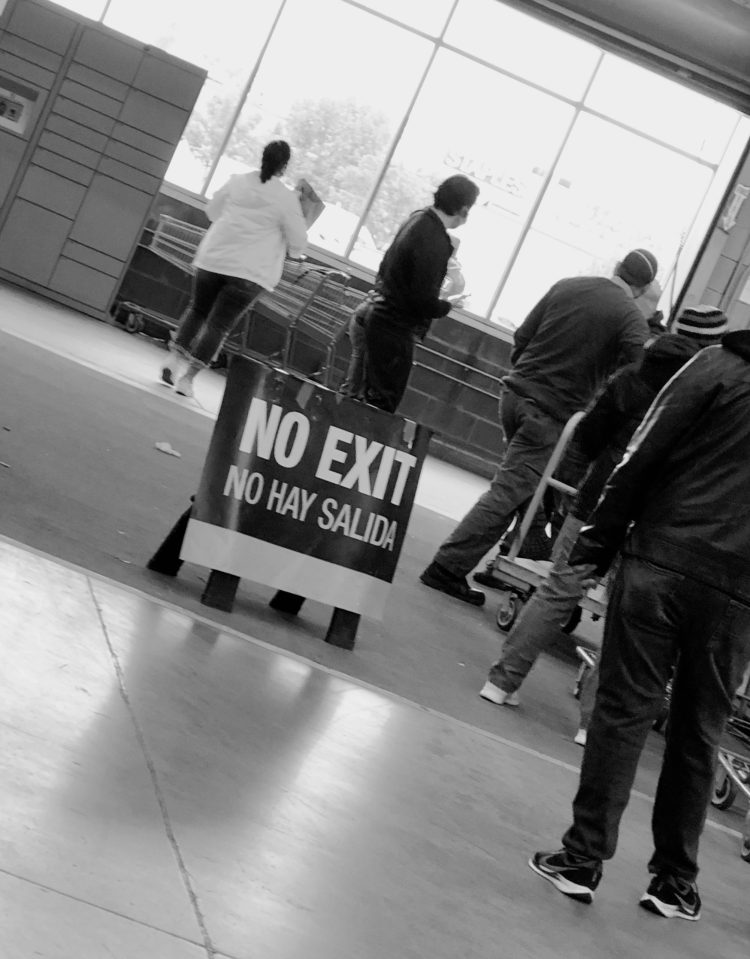
Back home, the tedious task of washing the groceries. Outside, with hose and almost frozen water, in the cold. With detergent, alcohol, chlorine, whatever. I don’t even want those bags in the house. Then, taking a shower, washing my hair and everything.
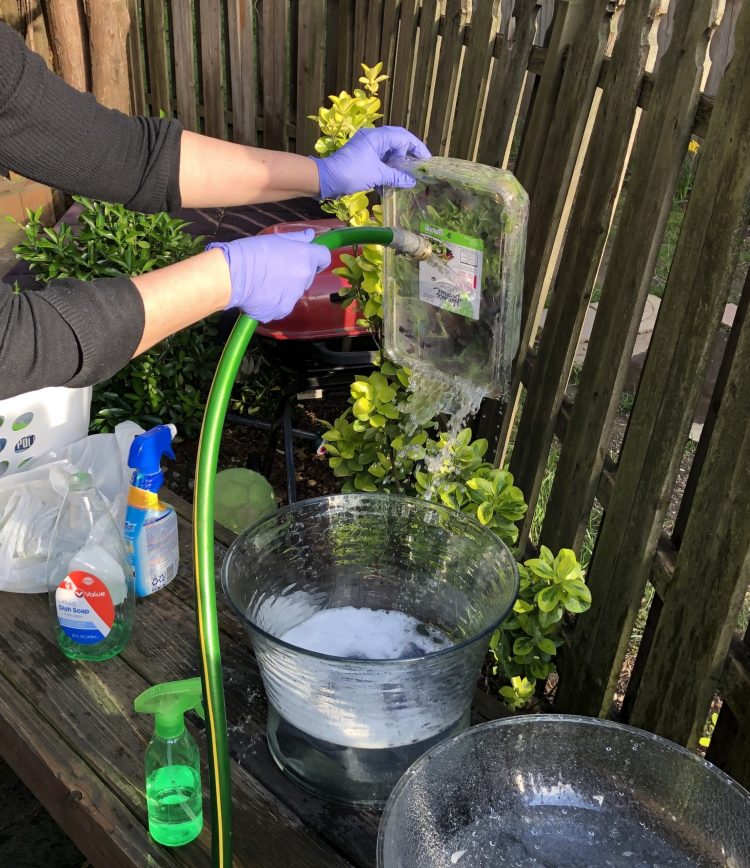
E Pluribus Unum
I go out for a ride in the car through Manhattan to escape a bit of this confinement. Wearing a mask, as we call it here. Nasobuco sounds too harsh to me. It sounds like a dirty word adopted for bad times. Mask is softer. It disguises the tragedy better.
I put down the car window, only for moments. I am thankful for having moved to Kew Gardens Hills, Queens. Here it’s much less dense. We are close to several communities of Bukharian Jews. Two cross the street while I wait for the light to change. They’re not wearing a mask. Someone yells at them, Put your f *** ng masks on! I raise the window.
E Pluribus Unum, says a huge bronze plaque at the entrance to the Midtown Tunnel. In diversity, one. The phrase, which appears on the United States seal designed by Charles Thompson, refers to the federal nature of the original 13 states, part of one same nation. It hangs from the beak of the bald eagle.

I cross the East River under the tunnel. Back in Manhattan, I take the FDR, as the Franklin Delano Roosevelt Freeway, which borders the East River, is called. E Pluribus Unum. The ironies of life. What would Roosevelt, the New Yorker who brought this country forward in the midst of the stock market crisis of the 1930s, and whose mandate coincided with World War II, do in the face of the pandemic? He who in the midst of the chaos implemented true policies in favor of plures; who promoted replacing ultra-liberalism for the welfare state, with social security programs such as retirement, the right to unions, the 40-hour work week, and the minimum wage….
Obama has referred to the White House response to the coronavirus as an “absolute chaotic mess.” As I enter the epicenter, I think of him and Roosevelt. I can’t help but think of Trump and the governors who are irresponsibly calling for reopening states against the grain of common sense. Not to mention science. I think of the women in the Southwest, who annoyed, are screaming out for their beauty salons to open. Of the nonconformists of Michigan, those who come to the municipality with their combat weapons to “liberate themselves” from the “oppressive government.” Of those annoyed because they have to wear masks. I think of Lisa, a nurse at NYU Hospital, who has to go to a hotel to sleep, separated from her six-month-old son, for fear of contagion. E Pluribus Unum. Unfortunately, no.
Manhattan is a ghost city. Few cars. Few people. Much sadness.
I go through some streets of a residential neighborhood. The sun seems to ripen the buildings. A couple of joggers pass by.
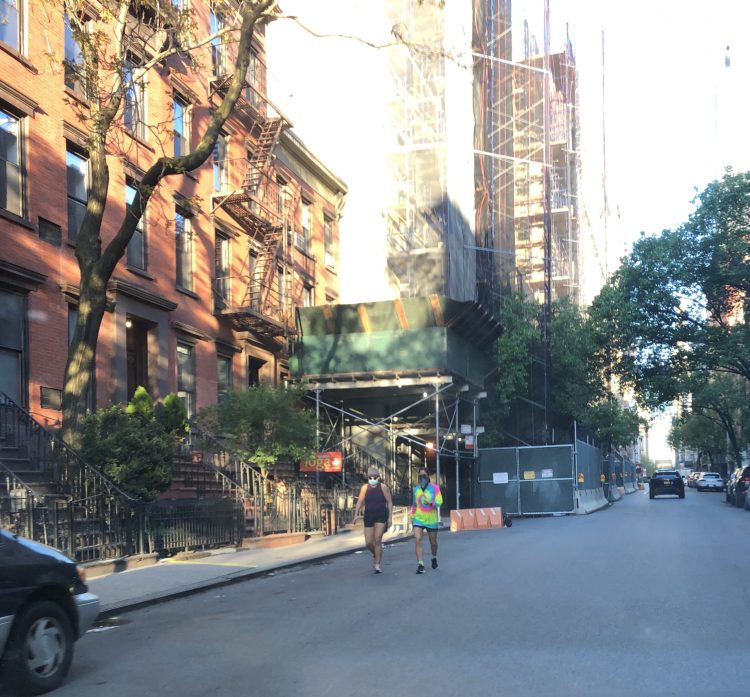
I continue through Times Squares. I barely stop; I barely breathe. I pass a Cafe. Reflections in the store windows. Everything dark. New York looks like Comala.
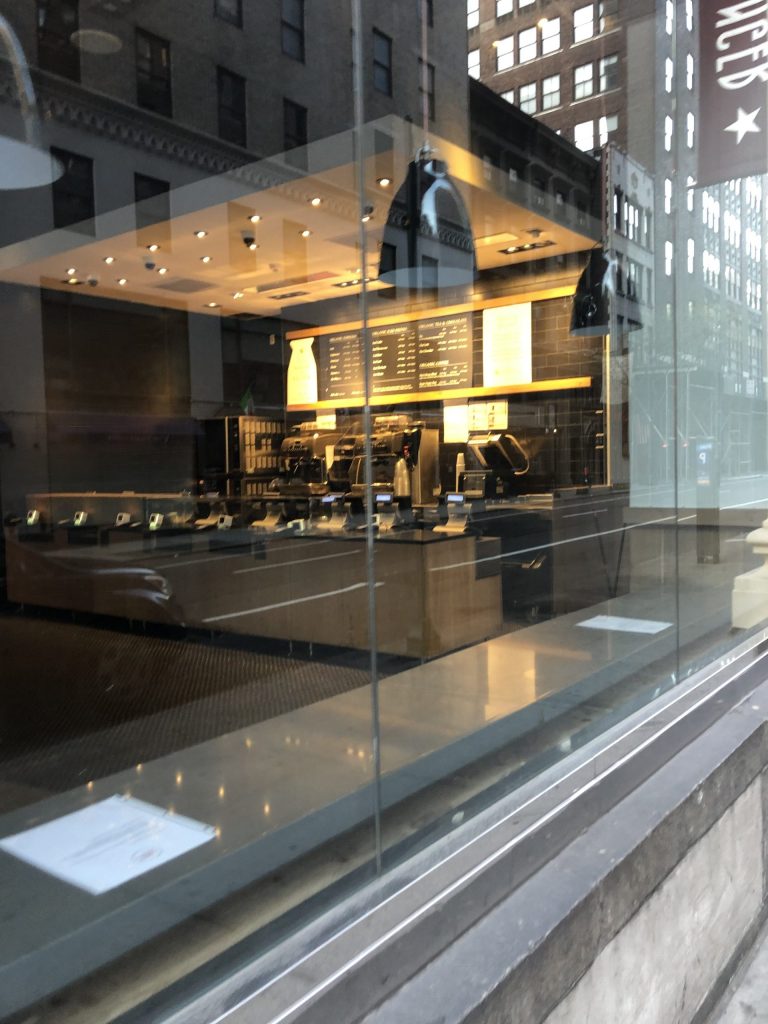
A delivery boy is about to start his pizza delivery rounds. The “essential workers” are today the kings of the city streets. Finally, the streets are theirs. Not a taxi driver yells at them. Not even a bus driver harasses them.
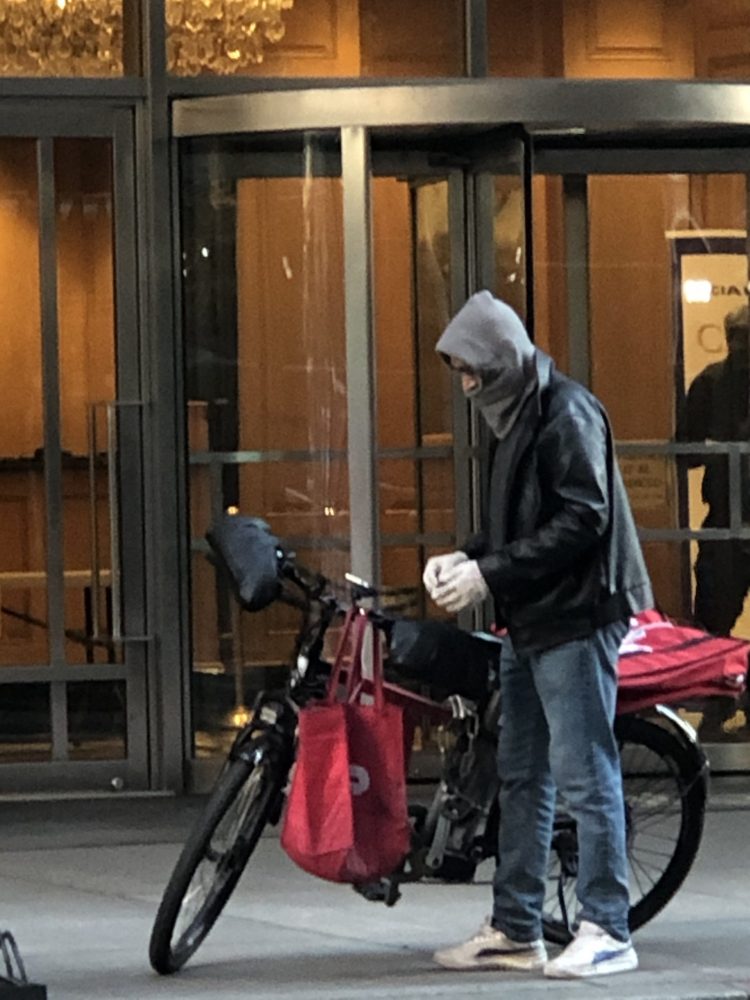
I digress, heading to the Lower East Side. I stop by a sidewalk to answer a call. After a while, a commotion begins. I realize it is 7 pm. I hang up and try to catch every second. I realize that I’m close to the Presbyterian Hospital. Casseroles, whistles, cowbells. Sounds without faces. Chilling. Beautiful. I cry. E Pluribus Unum.
On the way back, I pass through Jackson Heights, my old neighborhood. A couple of weeks ago my ex-neighbors organized a food drive for the undocumented. At first I thought of passing by the Elmhurst Hospital, where they have a truck to refrigerate the bodies of the deceased. I don’t dare.
I arrive home. I process. I check my e-mail. A few days ago I asked my friend Nadia to tell me what she missed most about New York. Her answer comes in today: “I miss my always vibrant city, the heterogeneity of my people, the music in the streets, art in any of its forms surprising me on every corner, the voices of the boys playing in the squares, the feat of choosing a different restaurant every week, the dancers on the subway, walking and discovering new things, the complicity in the spontaneous interaction between strangers, the audacity of New Yorkers of being and showing how they are sung.… The colors, the flavors, the smells, the sounds, the constant discovery of different places.… “
And I, although I’m not far away today, also miss that New York.
